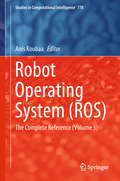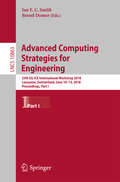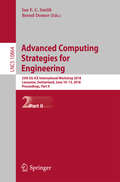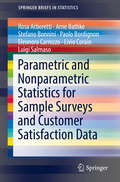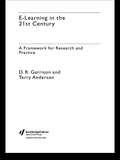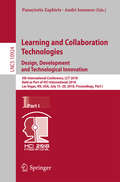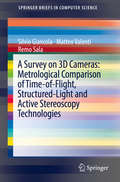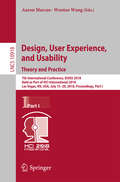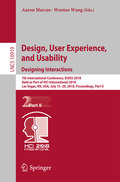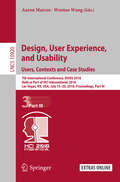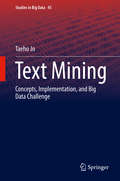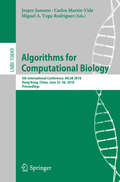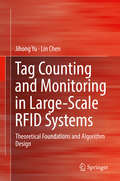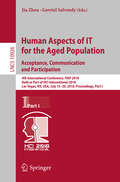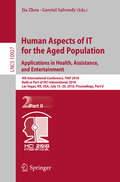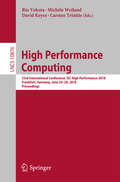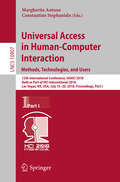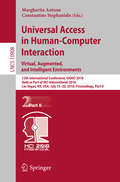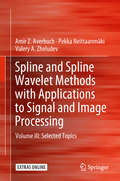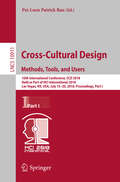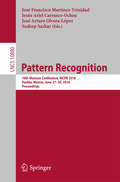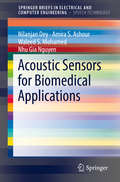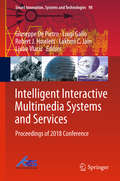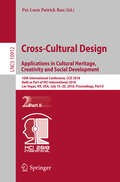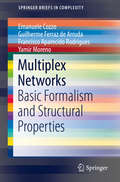- Table View
- List View
Robot Operating System: The Complete Reference (Volume 3) (Studies in Computational Intelligence #778)
by Anis KoubaaBuilding on the successful first and second volumes, this book is the third volume of the Springer book on the Robot Operating System (ROS): The Complete Reference. The Robot Operating System is evolving from year to year with a wealth of new contributed packages and enhanced capabilities. Further, the ROS is being integrated into various robots and systems and is becoming an embedded technology in emerging robotics platforms. The objective of this third volume is to provide readers with additional and comprehensive coverage of the ROS and an overview of the latest achievements, trends and packages developed with and for it. Combining tutorials, case studies, and research papers, the book consists of sixteen chapters and is divided into five parts. Part 1 presents multi-robot systems with the ROS. In Part 2, four chapters deal with the development of unmanned aerial systems and their applications. In turn, Part 3 highlights recent work related to navigation, motion planning and control. Part 4 discusses recently contributed ROS packages for security, ROS2, GPU usage, and real-time processing. Lastly, Part 5 deals with new interfaces allowing users to interact with robots. Taken together, the three volumes of this book offer a valuable reference guide for ROS users, researchers, learners and developers alike. Its breadth of coverage makes it a unique resource.
Advanced Computing Strategies for Engineering: 25th EG-ICE International Workshop 2018, Lausanne, Switzerland, June 10-13, 2018, Proceedings, Part I (Lecture Notes in Computer Science #10863)
by Ian F. Smith Bernd DomerThis double volume set ( LNAI 10863-10864) constitutes the refereed proceedings of the 25th International Workshop, EG-ICE 2018, held in Lausanne, Switzerland, in June 2018. The 58 papers presented in this volume were carefully reviewed and selected from 108 submissions. The papers are organized in topical sections on Advanced Computing in Engineering, Computer Supported Construction Management, Life-Cycle Design Support, Monitoring and Control Algorithms in Engineering, and BIM and Engineering Ontologies.
Advanced Computing Strategies for Engineering: 25th EG-ICE International Workshop 2018, Lausanne, Switzerland, June 10-13, 2018, Proceedings, Part II (Lecture Notes in Computer Science #10864)
by Ian F. Smith Bernd DomerThis double volume set ( LNAI 10863-10864) constitutes the refereed proceedings of the 25th International Workshop, EG-ICE 2018, held in Lausanne, Switzerland, in June 2018. The 58 papers presented in this volume were carefully reviewed and selected from 108 submissions. The papers are organized in topical sections on Advanced Computing in Engineering, Computer Supported Construction Management, Life-Cycle Design Support, Monitoring and Control Algorithms in Engineering, and BIM and Engineering Ontologies.
Parametric and Nonparametric Statistics for Sample Surveys and Customer Satisfaction Data (SpringerBriefs in Statistics)
by Stefano Bonnini Livio Corain Luigi Salmaso Rosa Arboretti Eleonora Carrozzo Arne Bathke Paolo BordignonThis book deals with problems related to the evaluation of customer satisfaction in very different contexts and ways. Often satisfaction about a product or service is investigated through suitable surveys which try to capture the satisfaction about several partial aspects which characterize the perceived quality of that product or service. This book presents a series of statistical techniques adopted to analyze data from real situations where customer satisfaction surveys were performed.The aim is to give a simple guide of the variety of analysis that can be performed when analyzing data from sample surveys: starting from latent variable models to heterogeneity in satisfaction and also introducing some testing methods for comparing different customers. The book also discusses the construction of composite indicators including different benchmarks of satisfaction. Finally, some rank-based procedures for analyzing survey data are also shown.
E-Learning in the 21st Century: A Framework for Research and Practice
by D. Randy GarrisonThere is currently a technological revolution taking place in higher education. The growth of e-learning is being described as explosive, unprecedented, and above all, disruptive. This timely and comprehensive book provides a coherent framework for understanding e-learning in higher education.The authors draw on their extensive research in the area to explore the technological, pedagogical and organisational implications of e-learning, and more importantly, they provide practical models for educators to use to realise the full potential of e-learning. A unique feature of the book is that the authors focus less on the ever-evolving technologies and more on the search for an understanding of these technologies from an educational perspective.This book will be invaluable for researchers, practitioners and senior administrators looking for guidance on how to successfully adopt e-learning in their institutions. It will also appeal to anyone with an interest in the impact of e-learning on higher education and society.
Learning and Collaboration Technologies. Design, Development and Technological Innovation: 5th International Conference, LCT 2018, Held as Part of HCI International 2018, Las Vegas, NV, USA, July 15-20, 2018, Proceedings, Part I (Lecture Notes in Computer Science #10924)
by Panayiotis Zaphiris Andri IoannouThis two-volume set LNCS 10924 and 10925 constitute the refereed proceedings of the 5th International Conference on Learning and Collaboration Technologies, LCT 2018, held as part of the 20th International Conference on Human-Computer Interaction, HCII 2018, in Las Vegas, NV, USA in July 2018. The 1171 papers presented at HCII 2018 conferences were carefully reviewed and selected from 4346 submissions. The papers cover the entire field of human-computer interaction, addressing major advances in knowledge and effective use of computers in a variety of applications areas. The papers in this volume are organized in the following topical sections: designing and evaluating systems and applications, technological innovation in education, learning and collaboration, learners, engagement, motification, and skills, games and gamification of learning, technology-enhanced teaching and assessment, computing and engineering education.
A Survey on 3D Cameras: Metrological Comparison of Time-of-Flight, Structured-Light and Active Stereoscopy Technologies (SpringerBriefs in Computer Science)
by Silvio Giancola Matteo Valenti Remo SalaThis book is a valuable resource to deeply understand the technology used in 3D cameras. In this book, the authors summarize and compare the specifications of the main 3D cameras available in the mass market. The authors present a deep metrological analysis of the main camera based on the three main technologies: Time-of-Flight, Structured-Light and Active Stereoscopy, and provide qualitative results for any user to understand the underlying technology within 3D camera, as well as practical guidance on how to get the most of them for a given application.
Design, User Experience, and Usability: 7th International Conference, DUXU 2018, Held as Part of HCI International 2018, Las Vegas, NV, USA, July 15-20, 2018, Proceedings, Part I (Lecture Notes in Computer Science #10918)
by Aaron Marcus Wentao WangThe three-volume set LNCS 10918, 10919, and 10290 constitutes the proceedings of the 7th International Conference on Design, User Experience, and Usability, DUXU 2018, held as part of the 20th International Conference on Human-Computer Interaction, HCII 2018, in Las Vegas, NV, USA in July 2018. The total of 1171 papers presented at the HCII 2018 conferences were carefully reviewed and selected from 4346 submissions. The papers cover the entire field of human-computer interaction, addressing major advances in knowledge and effective use of computers in a variety of applications areas.The total of 165 contributions included in the DUXU proceedings were carefully reviewed and selected for inclusion in this three-volume set. The 55 papers included in this volume are organized in topical sections on design thinking, methods and practice, usability and user experience evaluation methods and tools, and DUXU in software development.
Design, User Experience, and Usability: 7th International Conference, DUXU 2018, Held as Part of HCI International 2018, Las Vegas, NV, USA, July 15-20, 2018, Proceedings, Part II (Lecture Notes in Computer Science #10919)
by Aaron Marcus Wentao WangThe three-volume set LNCS 10918, 10919, and 10290 constitutes the proceedings of the 7th International Conference on Design, User Experience, and Usability, DUXU 2018, held as part of the 20th International Conference on Human-Computer Interaction, HCII 2018, in Las Vegas, NV, USA in July 2018. The total of 1171 papers presented at the HCII 2018 conferences were carefully reviewed and selected from 4346 submissions. The papers cover the entire field of human-computer interaction, addressing major advances in knowledge and effective use of computers in a variety of applications areas. The total of 165 contributions included in the DUXU proceedings were carefully reviewed and selected for inclusion in this three-volume set. The 50 papers included in this volume are organized in topical sections on design, education and creativity, GUI, visualization and image design, multimodal DUXU, and mobile DUXU.
Design, User Experience, and Usability: 7th International Conference, DUXU 2018, Held as Part of HCI International 2018, Las Vegas, NV, USA, July 15–20, 2018, Proceedings, Part III (Lecture Notes in Computer Science #10920)
by Aaron Marcus Wentao WangThe three-volume set LNCS 10918, 10919, and 10290 constitutes the proceedings of the 7th International Conference on Design, User Experience, and Usability, DUXU 2018, held as part of the 20th International Conference on Human-Computer Interaction, HCII 2018, in Las Vegas, NV, USA in July 2018. The total of 1171 papers presented at the HCII 2018 conferences were carefully reviewed and selected from 4346 submissions. The papers cover the entire field of human-computer interaction, addressing major advances in knowledge and effective use of computers in a variety of applications areas. The total of 165 contributions included in the DUXU proceedings were carefully reviewed and selected for inclusion in this three-volume set. The 60 papers included in this volume are organized in topical sections on emotion, motivation, and persuasion design, DUXU and children, DUXU in automotive and transport, and DUXU in culture and art.
Text Mining: Concepts, Implementation, and Big Data Challenge (Studies in Big Data #45)
by Taeho JoThis book discusses text mining and different ways this type of data mining can be used to find implicit knowledge from text collections. The author provides the guidelines for implementing text mining systems in Java, as well as concepts and approaches. The book starts by providing detailed text preprocessing techniques and then goes on to provide concepts, the techniques, the implementation, and the evaluation of text categorization. It then goes into more advanced topics including text summarization, text segmentation, topic mapping, and automatic text management.
Algorithms for Computational Biology: 5th International Conference, AlCoB 2018, Hong Kong, China, June 25–26, 2018, Proceedings (Lecture Notes in Computer Science #10849)
by Carlos Martín-Vide Miguel A. Vega-Rodríguez Jesper JanssonThis book constitutes the proceedings of the 5th InternationalConference on Algorithms for Computational Biology, AlCoB 2018, held in Hong Kong, China, in June 2018. The 11 full papers presented together with 1 invited paper were carefully reviewed and selected from 20 submissions. They are organized in the following topical sections: Phylogenetics, Sequence Rearrangement and Analysis, Systems Biology and Other Biological Processes.
Tag Counting and Monitoring in Large-Scale RFID Systems: Theoretical Foundations and Algorithm Design
by Lin Chen Jihong YuThis book provides a comprehensive treatment of the theoretical foundation and algorithmic tools necessary in the design of efficient tag counting and monitoring algorithms in emerging RFID systems. The book delivers an in-depth analysis on the following problems ranging from theoretical modeling and analysis, to practical algorithm design and optimization: Stability analysis of the frame slotted Aloha protocol, the de facto standard in RFID tag counting and identification; Tag population estimation in dynamic RFID systems; Missing tag event detection in the presence of unexpected tags; Missing tag event detection in multi-group multi-region RFID systems. The target readers are researchers and advanced-level engineering students interested in acquiring in-depth knowledge on the topic and on RFID systems and their applications.
Human Aspects of IT for the Aged Population. Acceptance, Communication and Participation: 4th International Conference, ITAP 2018, Held as Part of HCI International 2018, Las Vegas, NV, USA, July 15–20, 2018, Proceedings, Part I (Lecture Notes in Computer Science #10926)
by Gavriel Salvendy Jia ZhouThis book constitutes the proceedings of the 4th International Conference onHuman Aspects of IT for the Aged Population, ITAP 2018, held as part of the 20th International Conference, HCI International 2018, which took place in Las Vegas, Nevada, in July 2018.The total of 1171 papers and 160 posters included in the 30 HCII 2018 proceedings volumes was carefully reviewed and selected from 4346 submissions. ITAP 2018 includes a total of 84 papers. They were organized in topical sections as follows: Part I: aging and technology acceptance; aging and interaction; intergenerational communication and social participation. Part II: health care technologies and services for the elderly; intelligent environments for aging; and games and entertainment for the elderly.
Human Aspects of IT for the Aged Population. Applications in Health, Assistance, and Entertainment: 4th International Conference, ITAP 2018, Held as Part of HCI International 2018, Las Vegas, NV, USA, July 15–20, 2018, Proceedings, Part II (Lecture Notes in Computer Science #10927)
by Gavriel Salvendy Jia ZhouThis book constitutes the proceedings of the 4th International Conference onHuman Aspects of IT for the Aged Population, ITAP 2018, held as part of the 20th International Conference, HCI International 2018, which took place in Las Vegas, Nevada, in July 2018. The total of 1171 papers and 160 posters included in the 30 HCII 2018 proceedings volumes was carefully reviewed and selected from 4346 submissions. ITAP 2018 includes a total of 84 papers. They were organized in topical sections as follows: Part I: aging and technology acceptance; aging and interaction; intergenerational communication and social participation. Part II: health care technologies and services for the elderly; intelligent environments for aging; and games and entertainment for the elderly.
High Performance Computing: 33rd International Conference, ISC High Performance 2018, Frankfurt, Germany, June 24-28, 2018, Proceedings (Lecture Notes in Computer Science #10876)
by David Keyes Rio Yokota Michèle Weiland Carsten TrinitisThis book constitutes the refereed proceedings of the 33rd International Conference, ISC High Performance 2018, held in Frankfurt, Germany, in June 2018. The 20 revised full papers presented in this book were carefully reviewed and selected from 81 submissions. The papers cover the following topics: Resource Management and Energy Efficiency; Performance Analysis and Tools; Exascale Networks; Parallel Algorithms.
Universal Access in Human-Computer Interaction. Methods, Technologies, and Users: 12th International Conference, UAHCI 2018, Held as Part of HCI International 2018, Las Vegas, NV, USA, July 15-20, 2018, Proceedings, Part I (Lecture Notes in Computer Science #10907)
by Margherita Antona Constantine StephanidisThis two-volume set LNCS 10907 and 10908 constitutes the refereed proceedings of the 12th International Conference on Universal Access in Human-Computer Interaction, UAHCI 2018, held as part of HCI International 2018 in Las Vegas, NV, USA, in July 2018.The total of 1170 papers and 195 posters included in the 30 HCII 2018 proceedings volumes was carefully reviewed and selected from 4373 submissions.The 49 papers presented in this volume were organized in topical sections named: design for all, accessibility and usability; alternative I/O techniques, multimodality and adaptation; non-visual interaction; and designing for cognitive disabilities.
Universal Access in Human-Computer Interaction. Virtual, Augmented, and Intelligent Environments: 12th International Conference, UAHCI 2018, Held as Part of HCI International 2018, Las Vegas, NV, USA, July 15-20, 2018, Proceedings, Part II (Lecture Notes in Computer Science #10908)
by Margherita Antona Constantine StephanidisThis two-volume set LNCS 10907 and 10908 constitutes the refereed proceedings of the 12th International Conference on Universal Access in Human-Computer Interaction, UAHCI 2018, held as part of HCI International 2018 in Las Vegas, NV, USA, in July 2018.The total of 1170 papers and 195 posters included in the 30 HCII 2018 proceedings volumes was carefully reviewed and selected from 4373 submissions.The 48 papers presented in this volume were organized in topical sections named: virtual and augmented reality for universal access; intelligent assistive environments; and access to the web, social media, education, culture and social innovation.
Spline and Spline Wavelet Methods with Applications to Signal and Image Processing: Volume III: Selected Topics
by Pekka Neittaanmäki Amir Z. Averbuch Valery A. ZheludevThis book provides a practical guide, complete with accompanying Matlab software, to many different types of polynomial and discrete splines and spline-based wavelets, multiwavelets and wavelet frames in signal and image processing applications. In self-contained form, it briefly outlines a broad range of polynomial and discrete splines with equidistant nodes and their signal-processing-relevant properties. In particular, interpolating, smoothing, and shift-orthogonal splines are presented.
Cross-Cultural Design. Methods, Tools, and Users: 10th International Conference, CCD 2018, Held as Part of HCI International 2018, Las Vegas, NV, USA, July 15-20, 2018, Proceedings, Part I (Lecture Notes in Computer Science #10911)
by Pei-Luen Patrick RauThis two-volume set LNCS 10911 and 10912 constitutes the refereed proceedings of the 10th International Conference on Cross-Cultural Design, CCD 2018, held as part of HCI International 2018 in Las Vegas, NV, USA, in July 2018.The total of 1170 papers and 195 posters included in the 30 HCII 2018 proceedings volumes was carefully reviewed and selected from 4373 submissions.The 36 regular papers presented in this volume were organized in topical sections named: cross-cultural design methods and tools; cross-cultural product design; cultural Differences; and culture, emotions and design.
Pattern Recognition: 10th Mexican Conference, MCPR 2018, Puebla, Mexico, June 27-30, 2018, Proceedings (Lecture Notes in Computer Science #10880)
by Jesús Ariel Carrasco-Ochoa José Francisco Martínez-Trinidad José Arturo Olvera-López Sudeep SarkarThis book constitutes the proceedings of the 10th Mexican Conference on Pattern Recognition, MCPR 2018, held in Puebla, Mexico, in June 2018. The 28 papers presented in this volume were carefully reviewed and selected from 44 submissions. They were organized in topical sections named: pattern recognition principles; deep learning, neural networks and associative memories; data mining; and computer vision.
Acoustic Sensors for Biomedical Applications (SpringerBriefs in Speech Technology)
by Nilanjan Dey Amira S. Ashour Nhu Gia Nguyen Waleed S. MohamedIn this book, application-related studies for acoustic biomedical sensors are covered in depth. The book features an array of different biomedical signals, including acoustic biomedical signals as well as the thermal biomedical signals, magnetic biomedical signals, and optical biomedical signals to support healthcare. It employs signal processing approaches, such as filtering, Fourier transform, spectral estimation, and wavelet transform. The book presents applications of acoustic biomedical sensors and bio-signal processing for prediction, detection, and monitoring of some diseases from the phonocardiogram (PCG) signal analysis. Several challenges and future perspectives related to the acoustic sensors applications are highlighted. This book supports the engineers, researchers, designers, and physicians in several interdisciplinary domains that support healthcare.
Intelligent Interactive Multimedia Systems and Services: Proceedings of 2018 Conference (Smart Innovation, Systems and Technologies #98)
by Lakhmi C. Jain Robert J. Howlett Luigi Gallo Giuseppe De Pietro Ljubo VlacicThis volume presents a series of carefully selected papers on the theme of Intelligent Interactive Multimedia Systems and Services (IIMSS-18), but also including contributions on Innovation in Medicine and Healthcare (InMed-18) and Smart Transportation Systems (STS-18). The papers were presented at the Smart Digital Futures 2018 multi-theme conference, which grouped the AMSTA, IDT, InMed, SEEL, STS and IIMSS conferences in one venue in Gold Coast, Australia in June 2018.IIMSS-18 included sessions on 'Cognitive Systems and Big Data Analytics', 'Data Processing and Secure Systems', 'Innovative Information Services for Advanced Knowledge Activity', 'Autonomous System' and ' Image Processing'. InMed-18 papers cover major areas of 'Digital Architecture for Internet of Things, Big data, Cloud and Mobile IT in Healthcare' and 'Advanced ICT for Medical and Healthcare'. STS-18 papers provide a comprehensive overview of various aspects of current research into intelligent transportation technology.
Cross-Cultural Design. Applications in Cultural Heritage, Creativity and Social Development: 10th International Conference, CCD 2018, Held as Part of HCI International 2018, Las Vegas, NV, USA, July 15-20, 2018, Proceedings, Part II (Lecture Notes in Computer Science #10912)
by Pei-Luen Patrick RauThis two-volume set LNCS 10911 and 10912 constitutes the refereed proceedings of the 10th International Conference on Cross-Cultural Design, CCD 2018, held as part of HCI International 2018 in Las Vegas, NV, USA, in July 2018.The total of 1170 papers and 195 posters included in the 30 HCII 2018 proceedings volumes was carefully reviewed and selected from 4373 submissions.The 37 regular papers presented in this volume were organized in topical sections named: culture, learning and games; culture and creativity; cross-cultural design for social change and development.
Multiplex Networks: Basic Formalism and Structural Properties (SpringerBriefs in Complexity)
by Emanuele Cozzo Guilherme Ferraz de Arruda Francisco Aparecido Rodrigues Yamir MorenoThis book provides the basis of a formal language and explores its possibilities in the characterization of multiplex networks. Armed with the formalism developed, the authors define structural metrics for multiplex networks. A methodology to generalize monoplex structural metrics to multiplex networks is also presented so that the reader will be able to generalize other metrics of interest in a systematic way. Therefore, this book will serve as a guide for the theoretical development of new multiplex metrics. Furthermore, this Brief describes the spectral properties of these networks in relation to concepts from algebraic graph theory and the theory of matrix polynomials. The text is rounded off by analyzing the different structural transitions present in multiplex systems as well as by a brief overview of some representative dynamical processes. Multiplex Networks will appeal to students, researchers, and professionals within the fields of network science, graph theory, and data science.
